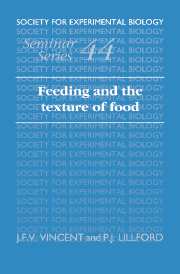Book contents
- Frontmatter
- Contents
- List of contributors
- Introduction
- Mechanical and fracture properties of cellular and fibrous materials
- Texture of plants and fruits
- Measuring meat texture and understanding its structural basis
- Food processing by mastication in cyprinid fish
- Quantitative aspects of the relationship between dentitions and diets
- The control of movements and forces during chewing
- The basic mechanics of mastication: man's adaptive success
- Integrating texture and physiology – techniques
- Brittle textures in processed foods
- The control and generation of texture in soft manufactured foods
- Texture and acceptability of human foods
- Index
The basic mechanics of mastication: man's adaptive success
Published online by Cambridge University Press: 14 January 2010
- Frontmatter
- Contents
- List of contributors
- Introduction
- Mechanical and fracture properties of cellular and fibrous materials
- Texture of plants and fruits
- Measuring meat texture and understanding its structural basis
- Food processing by mastication in cyprinid fish
- Quantitative aspects of the relationship between dentitions and diets
- The control of movements and forces during chewing
- The basic mechanics of mastication: man's adaptive success
- Integrating texture and physiology – techniques
- Brittle textures in processed foods
- The control and generation of texture in soft manufactured foods
- Texture and acceptability of human foods
- Index
Summary
Man is an omnivore: the uniquely adapted animal with a mouth which was well suited to a wide diet even before the advent of cooking. Manual collection of food allows a shorter snout which improves the mechanics of oral processing of food; this in turn allows a wider natural diet by inclusion of foods that would be impervious to enzyme action in the human gut without mastication. Both the reduction in particle size and wetting with saliva accelerate enzyme action in the gut and create a swallowable bolus. The success of this reflex activity is indicated by the infrequency of any consciousness of the process despite the continuing generous subconscious control.
The reduction of particle size is fundamentally important in the oral breakdown of natural unprocessed foods. Although foods developed by industry bear little structural relation to natural foods, basic appetites persist and the control of mastication maintains many general features used by other mammals. One aspect of human chewing behaviour is that much pleasure ensues from taste and smell. The rate of release of taste may be a governing factor in the popularity of many foods and may have unconsciously been important in their ‘design’. Taste is elicited by substances passing into solution in the saliva (e.g. the sugar from chewing gum, toffee), some foods are first hydrated by saliva (e.g. potato crisps, biscuits, breakfast cereals), others dissolve or melt (e.g. jellies). These events all involve continuously changing the internal characteristics of the foods to achieve a continuous source of taste and smell for the duration of chewing. Melting and significant hydration probably occur rarely in unprocessed foods.
- Type
- Chapter
- Information
- Feeding and the Texture of Food , pp. 143 - 166Publisher: Cambridge University PressPrint publication year: 1991
- 4
- Cited by



